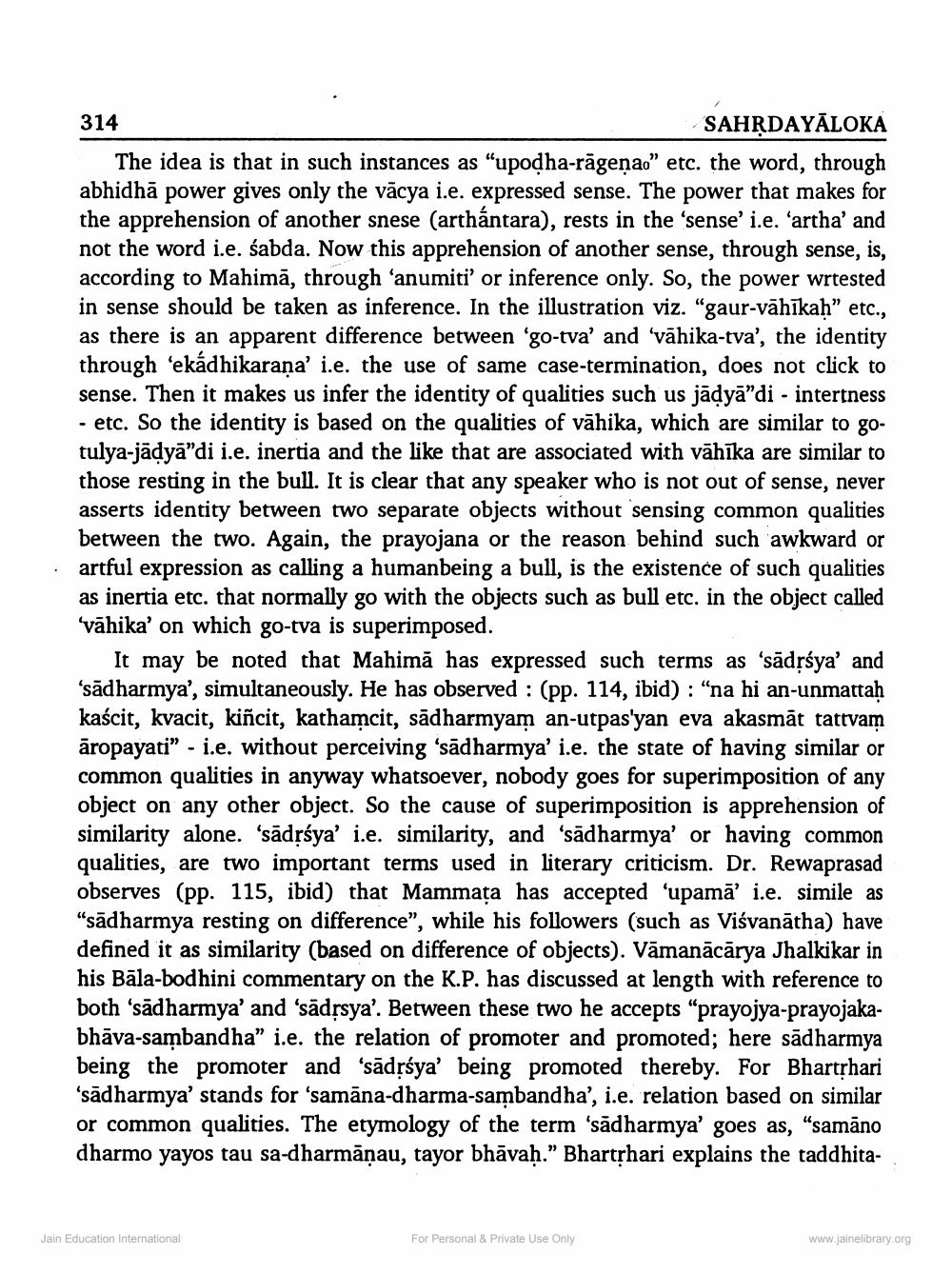________________
314
SAHṚDAYĀLOKA
The idea is that in such instances as "upoḍha-rageṇao" etc. the word, through abhidhā power gives only the vācya i.e. expressed sense. The power that makes for the apprehension of another snese (arthántara), rests in the 'sense' i.e. 'artha' and not the word i.e. sabda. Now this apprehension of another sense, through sense, is, according to Mahimā, through ‘anumiti' or inference only. So, the power wrtested in sense should be taken as inference. In the illustration viz. "gaur-vāhīkaḥ" etc., as there is an apparent difference between 'go-tva' and 'vähika-tva', the identity through 'ekádhikaraṇa' i.e. the use of same case-termination, does not click to sense. Then it makes us infer the identity of qualities such us jāḍyā”di - intertness - etc. So the identity is based on the qualities of vāhika, which are similar to gotulya-jāḍyā"di i.e. inertia and the like that are associated with vāhīka are similar to those resting in the bull. It is clear that any speaker who is not out of sense, never asserts identity between two separate objects without sensing common qualities between the two. Again, the prayojana or the reason behind such awkward or artful expression as calling a humanbeing a bull, is the existence of such qualities as inertia etc. that normally go with the objects such as bull etc. in the object called 'vähika' on which go-tva is superimposed.
It may be noted that Mahima has expressed such terms as 'sādṛśya' and 'sādharmya', simultaneously. He has observed: (pp. 114, ibid): "na hi an-unmattaḥ kaścit, kvacit, kiñcit, kathamcit, sādharmyam an-utpas'yan eva akasmāt tattvam āropayati" - i.e. without perceiving 'sadharmya' i.e. the state of having similar or common qualities in anyway whatsoever, nobody goes for superimposition of any object on any other object. So the cause of superimposition is apprehension of similarity alone. 'sādṛśya' i.e. similarity, and 'sādharmya' or having common qualities, are two important terms used in literary criticism. Dr. Rewaprasad observes (pp. 115, ibid) that Mammata has accepted 'upama' i.e. simile as "sādharmya resting on difference", while his followers (such as Viśvanatha) have defined it as similarity (based on difference of objects). Vāmanācārya Jhalkikar in his Bāla-bodhini commentary on the K.P. has discussed at length with reference to both 'sadharmya' and 'sādṛsya'. Between these two he accepts "prayojya-prayojakabhāva-sambandha" i.e. the relation of promoter and promoted; here sadharmya being the promoter and 'sādṛśya' being promoted thereby. For Bhartṛhari 'sādharmya' stands for 'samāna-dharma-sambandha', i.e. relation based on similar or common qualities. The etymology of the term 'sadharmya' goes as, "samāno dharmo yayos tau sa-dharmāṇau, tayor bhāvaḥ." Bhartṛhari explains the taddhita
Jain Education International
For Personal & Private Use Only
www.jainelibrary.org




